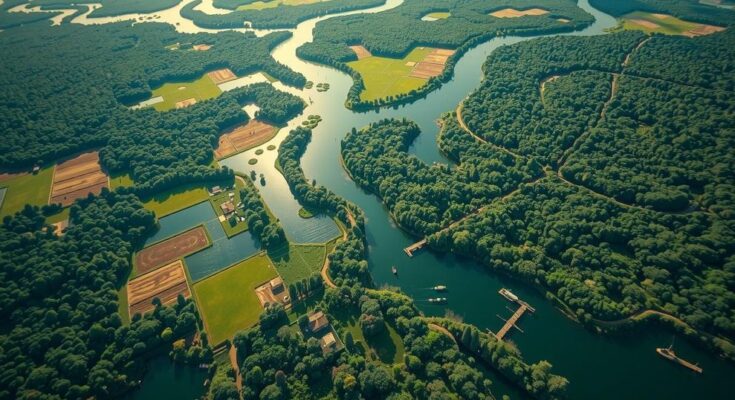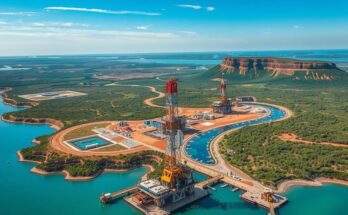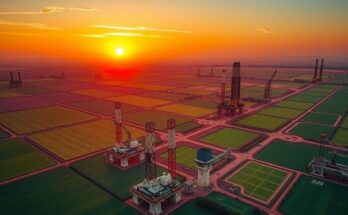The article outlines the trends and factors influencing internal migration in the Brazilian Amazon throughout the twentieth century. Internal migration, driven by job opportunities and economic necessity, has resulted in significant population growth in regions like Rondônia. Various waves of migration from different Brazilian states have shaped the socio-economic landscape, with ongoing challenges regarding land tenure and conflicts between large landowners and marginalized communities persisting to this day.
Migration in the Brazilian Amazon throughout the twentieth century has been significantly impacted by various socio-economic factors, primarily driven by the gold rushes, improvements in infrastructure, land acquisition, and job offerings associated with large-scale projects, particularly industrial mines and hydroelectric facilities. The population surge in Rondônia epitomizes these shifts: from 100,000 inhabitants in 1972 to over one million by 1990, reflecting a move towards urbanization as rural residents sought better opportunities in cities.
Internal migration has mainly involved movements from rural areas to urban centers, motivated by economic constraints in rural communities and the emergence of temporary jobs in construction sectors. Three primary migration sources emerged during this period: the impoverished Northeast, the agrarian South, and the Central West, which spurred agricultural expansion into the Amazon region. Historic migration patterns reveal additional layers, especially during the construction of major highways and railroads that facilitated access to remote areas previously considered inaccessible.
The completion of the Rodovia Belem-Brasília and later the Transamazônica marked pivotal moments in the land rush into the Amazon. Although initial migrations often involved wealthier families, a substantial number of poorer migrants, particularly from the Northeast, sought land through government programs aimed at colonization. Unfortunately, many of these individuals faced significant hardships and failed to secure formal land tenure, leading instead to precarious land occupation and reliance on others for employment.
By the mid-1970s, challenges such as inadequate support for smallholders and insufficient infrastructure highlighted the inadequacies of government strategies for managing the demographic influx and land distribution. Consequently, national policies shifted toward favoring large-scale agricultural enterprises, leading to further tension and conflict between large landowners and marginalized communities.
Meanwhile, population dynamics in states like Acre saw marked shifts in economic reliance from rubber tapping to cattle ranching, especially given the government’s agenda to expand agricultural production. This transformation sparked conflict as new cattle ranchers encroached on traditional livelihoods, resulting in notable activism led by figures like Chico Mendes, who fought for the rights of rubber tappers against aggressive land appropriation efforts from ranchers.
Moreover, migration has diversified significantly, as evidenced by the influx of individuals from southern Brazil seeking family farming opportunities in Mato Grosso. This unique migration pattern has included securing arable land in response to the challenges faced in their home states, fueled by socio-economic support networks that facilitated their settlement in the region. The colonization efforts in areas such as Goiás illustrate the long-standing legal and cultural contestations surrounding land acquisition in the Amazon.
Today’s migration trends within the Amazon largely consist of urbanization driven by economic necessity. Temporary job creation at construction sites related to hydroelectric projects has prompted thousands of individuals to relocate into urban centers like Rondônia, while historical gold mining activities continue to attract migrants seeking fortune in less formal sectors. Despite the many changes and challenges inherent in Amazonian migration, the enduring legacies of these historical movements continue to shape the socio-economic landscape of the region.
The Brazilian Amazon has experienced significant internal migration throughout the twentieth century, primarily driven by socio-economic developments linked to mining and infrastructure projects. Various demographic waves have shaped the region, with arrivals predominantly from Brazil’s northeast and southern areas, reflecting broader economic struggles and opportunities for land and employment. The evolution of migration patterns has been influenced by historical events such as highway construction and resource booms, resulting in both urbanization trends and conflicts over land rights. Understanding these migratory dynamics is essential to grasping the contemporary socio-economic landscape of the Amazon, as historical strife continues to impact current realities.
In conclusion, migration in the Brazilian Amazon is a complex phenomenon shaped by historical events, demographic shifts, and evolving economic conditions. From the early days of land rushes driven by infrastructure improvements to today’s urban migration patterns, the region’s socio-economic landscape remains heavily influenced by its migratory history. The interwoven narratives of different immigrant groups underscore the persistent challenges of land rights and economic opportunity within this dynamic and often contested environment.
Original Source: news.mongabay.com




